- Clone
- 24F.10C12 (See other available formats)
- Regulatory Status
- RUO
- Other Names
- B7-DC, PD-L2, PDL2, B7DC
- Isotype
- Mouse IgG2a, κ
- Ave. Rating
- Submit a Review
- Product Citations
- publications

-

Human monocyte-derived dendritic cells were stained with anti-human CD273 (clone 24F.10C12) KIRAVIA Blue 520™ (filled histogram) or mouse IgG2a, κ KIRAVIA Blue 520™ isotype control (open histogram).
| Cat # | Size | Price | Quantity Check Availability | Save | ||
|---|---|---|---|---|---|---|
| 329629 | 25 tests | £97 | ||||
| 329630 | 100 tests | £201 | ||||
CD273, known as B7-DC, is also called programmed death ligand 2 (PDL2). This ligand is a 25 kD type I transmembrane protein and a member of B7 family within the immunoglobulin receptor superfamily and is expressed on a subset of dendritic cells, liver and a small subset of macrophages as well as a few transformed cell lines. CD273 has been reported to be stimulatory on dendritic cells when cross-linked and to inhibit T cell activation upon engaging the PD-1 receptor. CD273 has also been reported to bind to an alternative receptor and to mediate T cell activation through such non-PD1 mediated interactions.
Product DetailsProduct Details
- Verified Reactivity
- Human
- Reported Reactivity
- African Green, Baboon, Cynomolgus, Rhesus
- Antibody Type
- Monoclonal
- Host Species
- Mouse
- Immunogen
- Human PD-L2 cDNA
- Formulation
- Phosphate-buffered solution, pH 7.2, containing 0.09% sodium azide
- Preparation
- The antibody was purified by affinity chromatography and conjugated with KIRAVIA Blue 520™ under optimal conditions.
- Concentration
- Lot-specific (to obtain lot-specific concentration and expiration, please enter the lot number in our Certificate of Analysis online tool.)
- Storage & Handling
- The antibody solution should be stored undiluted between 2°C and 8°C, and protected from prolonged exposure to light. Do not freeze.
- Application
-
FC - Quality tested
- Recommended Usage
-
Each lot of this antibody is quality control tested by immunofluorescent staining with flow cytometric analysis. For flow cytometric staining, the suggested use of this reagent is 5 µL per million cells in 100 µL staining volume or 5 µL per 100 µL of whole blood. It is recommended that the reagent be titrated for optimal performance for each application.
* KIRAVIA Blue 520™ has an excitation maximum of 495 nm, and a maximum emission of 520 nm.
KIRAVIA Blue™ 520 is a trademark of Sony. This product is subject to proprietary rights of Sony and is made and sold under license from Sony Corporation. This product is covered by U.S. Patent(s), pending patent applications and foreign equivalents.
Sony and the Sony logo are registered trademarks of Sony Corporation. - Excitation Laser
-
Blue Laser (488 nm)
-
Application References
(PubMed link indicates BioLegend citation) -
- Brown JA, et al. 2003. J. Immunol. 170:1257
- Rodig N, et al. 2003. Eur. J. Immunol. 33:3117
- RRID
-
AB_2922553 (BioLegend Cat. No. 329629)
AB_2922553 (BioLegend Cat. No. 329630)
Antigen Details
- Structure
- B7 Immunoglobulin superfamily, 25 kD
- Distribution
-
Dendritic cells, liver, few transformed cell lines, subset of macrophages
- Function
- Binds to PD-1 and alternative receptor; ligation on DC stimulates, inhibits T cell responses via PD-1 binding, stimulates T cells via alternative receptor binding and promotes tumor immunity
- Ligand/Receptor
- PD-1
- Cell Type
- Dendritic cells, Macrophages
- Biology Area
- Costimulatory Molecules, Immunology
- Molecular Family
- CD Molecules, Immune Checkpoint Receptors
- Antigen References
-
1. Shin T, et al. 2003. J. Exp. Med. 198:31.
2. Liu X, et al. 2003. J. Exp. Med. 197:1721.
3. Carreno BM, et al. 2002. Annu. Rev. Immunol. 20:29. - Gene ID
- 80380 View all products for this Gene ID
- UniProt
- View information about CD273 on UniProt.org
Related FAQs
Other Formats
View All CD273 Reagents Request Custom Conjugation| Description | Clone | Applications |
|---|---|---|
| Purified anti-human CD273 (B7-DC, PD-L2) | 24F.10C12 | FC,IHC-F,FA |
| Biotin anti-human CD273 (B7-DC, PD-L2) | 24F.10C12 | FC |
| APC anti-human CD273 (B7-DC, PD-L2) | 24F.10C12 | FC |
| PE anti-human CD273 (B7-DC, PD-L2) | 24F.10C12 | FC |
| Alexa Fluor® 647 anti-human CD273 (B7-DC, PD-L2) | 24F.10C12 | FC |
| Purified anti-human CD273 (B7-DC, PD-L2) (Maxpar® Ready) | 24F.10C12 | FC,CyTOF® |
| PE/Dazzle™ 594 anti-human CD273 (B7-DC, PD-L2) | 24F.10C12 | FC |
| Brilliant Violet 421™ anti-human CD273 (B7-DC, PD-L2) | 24F.10C12 | FC |
| TotalSeq™-A0008 anti-human CD273 (B7-DC, PD-L2) | 24F.10C12 | PG |
| TotalSeq™-C0008 anti-human CD273 (B7-DC, PD-L2) | 24F.10C12 | PG |
| Ultra-LEAF™ Purified anti-human CD273 (B7-DC, PD-L2) | 24F.10C12 | FC,IHC-F,FA |
| TotalSeq™-B0008 anti-human CD273 (B7-DC, PD-L2) | 24F.10C12 | PG |
| TotalSeq™-D0008 anti-human CD273 (B7-DC, PD-L2) | 24F.10C12 | PG |
| KIRAVIA Blue 520™ anti-human CD273 (B7-DC, PD-L2) | 24F.10C12 | FC |
Compare Data Across All Formats
This data display is provided for general comparisons between formats.
Your actual data may vary due to variations in samples, target cells, instruments and their settings, staining conditions, and other factors.
If you need assistance with selecting the best format contact our expert technical support team.
-
Purified anti-human CD273 (B7-DC, PD-L2)
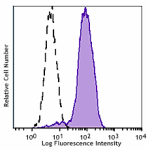
Human monocyte-derived dendritic cells were stained with ant... -
Biotin anti-human CD273 (B7-DC, PD-L2)
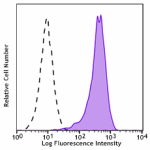
Monocyte-derived dendritic cells were stained with biotin an... -
APC anti-human CD273 (B7-DC, PD-L2)

Human monocyte-derived dendritic cells were stained with CD2... -
PE anti-human CD273 (B7-DC, PD-L2)

Monocyte-derived dendritic cells stained with 24F.10C12 PE -
Alexa Fluor® 647 anti-human CD273 (B7-DC, PD-L2)
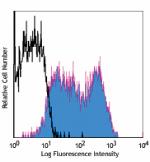
Monocyte-derived dendritic cells stained with 24F.10C12 Alex... -
Purified anti-human CD273 (B7-DC, PD-L2) (Maxpar® Ready)
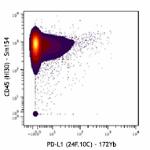
Human monocyte-derived dendritic cells stained wtih 154Sm-an... -
PE/Dazzle™ 594 anti-human CD273 (B7-DC, PD-L2)

Human monocyte-derived dendritic cells were stained with ant... -
Brilliant Violet 421™ anti-human CD273 (B7-DC, PD-L2)
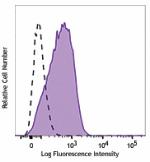
Human monocyte-derived dendritic cells were stained with ant... -
TotalSeq™-A0008 anti-human CD273 (B7-DC, PD-L2)
-
TotalSeq™-C0008 anti-human CD273 (B7-DC, PD-L2)
-
Ultra-LEAF™ Purified anti-human CD273 (B7-DC, PD-L2)

Human monocyte-derived dendritic cells were stained with ant... -
TotalSeq™-B0008 anti-human CD273 (B7-DC, PD-L2)
-
TotalSeq™-D0008 anti-human CD273 (B7-DC, PD-L2)
-
KIRAVIA Blue 520™ anti-human CD273 (B7-DC, PD-L2)
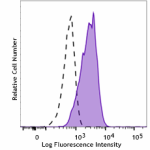
Human monocyte-derived dendritic cells were stained with ant...
 Login / Register
Login / Register 













Follow Us